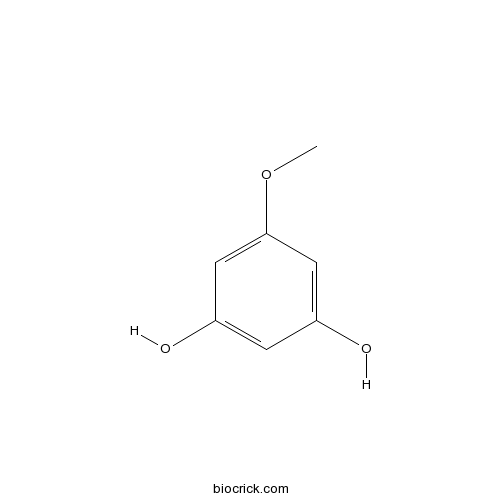5-MethoxyresorcinolCAS# 2174-64-3 |

Quality Control & MSDS
3D structure
Package In Stock
Number of papers citing our products

| Cas No. | 2174-64-3 | SDF | Download SDF |
| PubChem ID | 71648 | Appearance | Powder |
| Formula | C7H8O3 | M.Wt | 140.14 |
| Type of Compound | Phenols | Storage | Desiccate at -20°C |
| Solubility | Soluble in Chloroform,Dichloromethane,Ethyl Acetate,DMSO,Acetone,etc. | ||
| Chemical Name | 5-methoxybenzene-1,3-diol | ||
| SMILES | COC1=CC(=CC(=C1)O)O | ||
| Standard InChIKey | HDVRLUFGYQYLFJ-UHFFFAOYSA-N | ||
| Standard InChI | InChI=1S/C7H8O3/c1-10-7-3-5(8)2-6(9)4-7/h2-4,8-9H,1H3 | ||
| General tips | For obtaining a higher solubility , please warm the tube at 37 ℃ and shake it in the ultrasonic bath for a while.Stock solution can be stored below -20℃ for several months. We recommend that you prepare and use the solution on the same day. However, if the test schedule requires, the stock solutions can be prepared in advance, and the stock solution must be sealed and stored below -20℃. In general, the stock solution can be kept for several months. Before use, we recommend that you leave the vial at room temperature for at least an hour before opening it. |
||
| About Packaging | 1. The packaging of the product may be reversed during transportation, cause the high purity compounds to adhere to the neck or cap of the vial.Take the vail out of its packaging and shake gently until the compounds fall to the bottom of the vial. 2. For liquid products, please centrifuge at 500xg to gather the liquid to the bottom of the vial. 3. Try to avoid loss or contamination during the experiment. |
||
| Shipping Condition | Packaging according to customer requirements(5mg, 10mg, 20mg and more). Ship via FedEx, DHL, UPS, EMS or other couriers with RT, or blue ice upon request. | ||
| Description | 1. 5-Methoxyresorcinol is an antioxidant, it has aroxyl radical-scavenging action. |

5-Methoxyresorcinol Dilution Calculator

5-Methoxyresorcinol Molarity Calculator
| 1 mg | 5 mg | 10 mg | 20 mg | 25 mg | |
| 1 mM | 7.1357 mL | 35.6786 mL | 71.3572 mL | 142.7144 mL | 178.393 mL |
| 5 mM | 1.4271 mL | 7.1357 mL | 14.2714 mL | 28.5429 mL | 35.6786 mL |
| 10 mM | 0.7136 mL | 3.5679 mL | 7.1357 mL | 14.2714 mL | 17.8393 mL |
| 50 mM | 0.1427 mL | 0.7136 mL | 1.4271 mL | 2.8543 mL | 3.5679 mL |
| 100 mM | 0.0714 mL | 0.3568 mL | 0.7136 mL | 1.4271 mL | 1.7839 mL |
| * Note: If you are in the process of experiment, it's necessary to make the dilution ratios of the samples. The dilution data above is only for reference. Normally, it's can get a better solubility within lower of Concentrations. | |||||

Calcutta University

University of Minnesota

University of Maryland School of Medicine

University of Illinois at Chicago

The Ohio State University

University of Zurich

Harvard University

Colorado State University

Auburn University

Yale University

Worcester Polytechnic Institute

Washington State University

Stanford University

University of Leipzig

Universidade da Beira Interior

The Institute of Cancer Research

Heidelberg University

University of Amsterdam

University of Auckland

TsingHua University

The University of Michigan

Miami University

DRURY University

Jilin University

Fudan University

Wuhan University

Sun Yat-sen University

Universite de Paris

Deemed University

Auckland University

The University of Tokyo

Korea University
- 5-O-Demethylnobiletin
Catalog No.:BCN2958
CAS No.:2174-59-6
- Spectinomycin dihydrochloride
Catalog No.:BCC5166
CAS No.:21736-83-4
- Aristoliukine B
Catalog No.:BCN8096
CAS No.:217310-32-2
- PD 173212
Catalog No.:BCC7706
CAS No.:217171-01-2
- Etifoxine
Catalog No.:BCC1560
CAS No.:21715-46-8
- BCX 1470 methanesulfonate
Catalog No.:BCC1414
CAS No.:217099-44-0
- BCX 1470
Catalog No.:BCC1413
CAS No.:217099-43-9
- Hugorosenone
Catalog No.:BCN3776
CAS No.:217096-49-6
- Esomeprazole Magnesium trihydrate
Catalog No.:BCC1559
CAS No.:217087-09-7
- [Pyr1]-Apelin-13
Catalog No.:BCC7358
CAS No.:217082-60-5
- Apelin-17 (human, bovine)
Catalog No.:BCC5959
CAS No.:217082-57-0
- WB 4101 hydrochloride
Catalog No.:BCC6858
CAS No.:2170-58-3
- SB 268262
Catalog No.:BCC7916
CAS No.:217438-17-0
- (±)-J 113397
Catalog No.:BCC7423
CAS No.:217461-40-0
- 1-Hydroxy-2-oxopomolic acid
Catalog No.:BCN4931
CAS No.:217466-37-0
- Lucidumol A
Catalog No.:BCN8270
CAS No.:217476-73-8
- L-803,087 trifluoroacetate
Catalog No.:BCC7220
CAS No.:217480-26-7
- L-817,818
Catalog No.:BCC7221
CAS No.:217480-27-8
- Tulathromycin A
Catalog No.:BCC2019
CAS No.:217500-96-4
- Cyclo(Tyr-Val)
Catalog No.:BCN2413
CAS No.:21754-25-6
- Cyclo(Ala-Tyr)
Catalog No.:BCN2412
CAS No.:21754-26-7
- Taxoquinone
Catalog No.:BCN6660
CAS No.:21764-41-0
- BX 471
Catalog No.:BCC6029
CAS No.:217645-70-0
- 4-Cadinen-7-ol
Catalog No.:BCN4932
CAS No.:217650-27-6
Stopped-flow kinetic study of the aroxyl radical-scavenging action of catechins and vitamin C in ethanol and micellar solutions.[Pubmed:18500808]
J Agric Food Chem. 2008 Jun 25;56(12):4406-17.
Kinetic study of the aroxyl radical-scavenging action of catechins (epicatechin (EC), epicatechin gallate (ECG), epigallocatechin (EGC), and epigallocatechin gallate (EGCG)) and related compounds (methyl gallate (MG), 4-methylcatechol (MC), and 5-Methoxyresorcinol (MR)) has been performed. The second-order rate constant ( k s) for the reaction of these antioxidants with aroxyl radical has been measured in ethanol and aqueous Triton X-100 micellar solution (5.0 wt %). The k s values decreased in the order of EGCG > EGC > MC > ECG > EC > MG >> MR in ethanol, indicating that the reactivity of the OH groups in catechins decreased in the order of pyrogallol B-ring > catechol B-ring > gallate G-ring > resorcinol A-ring. The structure-activity relationship in the free radical-scavenging reaction by catechins has been clarified by the detailed analyses of the pH dependence of k s values. From the results, the p K a values have been determined for catechins. The monoanion form at catechol B- and resorcinol A-rings and dianion form at pyrogallol B- and gallate G-rings show the highest activity for free radical scavenging. It was found that the free radical-scavenging activities of catechins are 3.2-13 times larger than that of vitamin C at pH 7.0.


